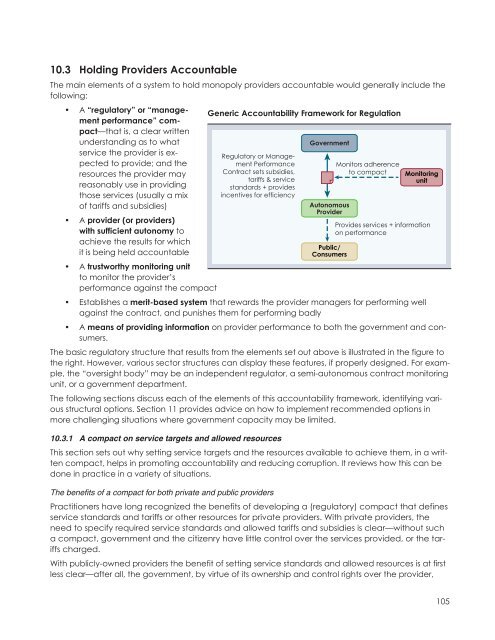A Sourcebook - UN-Water
A Sourcebook - UN-Water
A Sourcebook - UN-Water
You also want an ePaper? Increase the reach of your titles
YUMPU automatically turns print PDFs into web optimized ePapers that Google loves.
10.3 Holding Providers Accountable<br />
The main elements of a system to hold monopoly providers accountable would generally include the<br />
following:<br />
• A “regulatory” or “management<br />
performance” compact—that<br />
is, a clear written<br />
understanding as to what<br />
service the provider is expected<br />
to provide; and the<br />
resources the provider may<br />
reasonably use in providing<br />
those services (usually a mix<br />
of tariffs and subsidies)<br />
• A provider (or providers)<br />
with sufficient autonomy to<br />
achieve the results for which<br />
it is being held accountable<br />
• A trustworthy monitoring unit<br />
to monitor the provider’s<br />
performance against the compact<br />
• Establishes a merit-based system that rewards the provider managers for performing well<br />
against the contract, and punishes them for performing badly<br />
• A means of providing information on provider performance to both the government and consumers.<br />
The basic regulatory structure that results from the elements set out above is illustrated in the figure to<br />
the right. However, various sector structures can display these features, if properly designed. For example,<br />
the “oversight body” may be an independent regulator, a semi-autonomous contract monitoring<br />
unit, or a government department.<br />
The following sections discuss each of the elements of this accountability framework, identifying various<br />
structural options. Section 11 provides advice on how to implement recommended options in<br />
more challenging situations where government capacity may be limited.<br />
10.3.1 A compact on service targets and allowed resources<br />
This section sets out why setting service targets and the resources available to achieve them, in a written<br />
compact, helps in promoting accountability and reducing corruption. It reviews how this can be<br />
done in practice in a variety of situations.<br />
The benefits of a compact for both private and public providers<br />
Generic Accountability Framework for Regulation<br />
Regulatory or Management<br />
Performance<br />
Contract sets subsidies,<br />
tariffs & service<br />
standards + provides<br />
incentives for efficiency<br />
Government<br />
Autonomous<br />
Provider<br />
Public/<br />
Consumers<br />
Monitors adherence<br />
to compact<br />
Monitoring<br />
unit<br />
Provides services + information<br />
on performance<br />
Practitioners have long recognized the benefits of developing a (regulatory) compact that defines<br />
service standards and tariffs or other resources for private providers. With private providers, the<br />
need to specify required service standards and allowed tariffs and subsidies is clear—without such<br />
a compact, government and the citizenry have little control over the services provided, or the tariffs<br />
charged.<br />
With publicly-owned providers the benefit of setting service standards and allowed resources is at first<br />
less clear—after all, the government, by virtue of its ownership and control rights over the provider,<br />
105
















